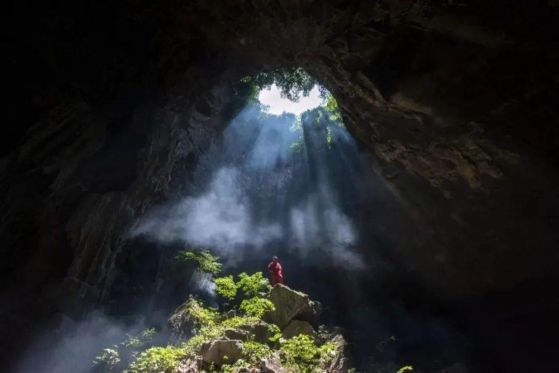Giant trees and new species at the bottom of the hole with a depth of 192 meters
Chinese scientists have discovered hitherto unknown animal and plant species at the bottom of a hole in the Guangxi region, Lue County in southern China, The Guardian reported recently.
While exploring the 30 caves in the region, speleologists discovered the largest abyss in the area – a karst formation, a hole with almost vertical walls – over 300 meters long, 150 meters wide and 192 meters deep.
The Guangxi 702 Honging Cave Expedition Team discovered the object using satellite imagery. The abyss is at the entrance to the underground Fugui River in Lue County. On May 2, Zhang Yuanhai, a senior engineer at the Institute of Karst Geology of the Chinese Geological Survey, went to the site for confirmation.
On May 6, an 8-member team of the scientific expedition, consisting of researchers from the Institute of Karst Geology of the Chinese Geological Survey and the Guangxi 702 Cave Expedition Team, left for the abyss site.
The team of the scientific expedition descended the rock for 100 meters and after a few hours of descent finally reached the lowest point at the bottom of the abyss. There it creeps slowly along the bottom, passing through a dense underground forest intertwined with vines.
“The ancient trees that grow concentrated toward the top of the abyss are nearly 40 meters high, and the dense shady plants almost cover our shoulders,” said Chen Lixin, head of the Guangxi 702 Cave Expedition Team.
“I would not be surprised to learn that there are species found in these caves that have never been reported or described by science,” Lisin told The Guardian.
“Three large openings have been carved into the walls of the abyss, which are believed to be the remains of caves in the early stages of the evolution of the karst formation. At the bottom of the abyss there is a well-preserved virgin forest system, which hides a large number of collapsed stones. “Whether or not this is evidence of evolution again, it is also a unique ecosystem after its formation that has high scientific and popular science value,” said Zhang Yuanhai, a senior engineer at the Institute of Karst Geology of the Chinese Geological Survey.
From a geological point of view, the abyss is a large karst abyss with exceptional spatial and morphological characteristics, such as huge volumes, steep rock walls and deep smoothly shaped vertical or barrel-shaped contours. The abyss usually develops in soluble rock layers of enormous thickness and deep water mass, leading underground or to the surface, with an average width and depth of over 100 meters, and the bottom is usually connected by underground rivers.
Leye County belongs to a typical karst region in southern China. This is the location of the world’s largest group of divers, the area is known as the “World Museum of Divers”. So far, the number of divers in Lue County has increased to 30.
Lisin’s prediction of new species is likely to come true, because isolated environments around the world have long created interesting, unique plants and animals that adapt to their biomes. The Galapagos Islands are perhaps the most famous example, there are several native species that are not found anywhere else.
Sources:
Scientists Discover Ancient Forest at Bottom of Gigantic Sinkhole, Futurism
Guangxi Leye discovered Xintiankeng as deep as 192 meters, www.xv
Note: How did the abyss form?
The formation of the sink must meet different conditions simultaneously.
The most important are the rock characteristics. First, the thickness of the limestone layer must be sufficient to provide sufficient space for the formation of an abyss. Second, the thickness of the vadose zone (rock layer containing gas) must be large enough. Third, the rock layer must be parallel to the earth’s surface.
The second factor is the hydrological conditions. First, the water level of the underground river must be deep. Second, the rainfall must be large enough, and the flow and power of the underground river must be large enough to wash away the fallen stones. In addition, the relief must be suitable for the collapse of rock layers.
Depending on the type of genesis, sinkholes can be divided into two types – by collapse or by erosion. The formation of the collapsed abyss is divided into three stages: an underground river, a collapsed hall and opening holes in the ceiling. The erosion type sinkhole is formed by the continuous erosion and expansion of the surface water flow and the deepening of the breakthrough in the layer of carbonate rocks.
The name of the abyss karst formation comes from Croatian and Slovenian. It comes from the Proto-Slavic word “nora”, meaning pit, hole, precipice.
Several places in Southeast Europe (Croatia, Czech Republic, Hungary, Romania, Montenegro, Slovenia) are named Ponor due to the associated karst openings. In Bulgaria this is Ponor mountain near Lakatnik.
Photo: Cave researchers come across an abyss in the Leye County. It is 306 meters long, 150 meters wide and 192 meters deep. Credit: news.hsw.cn









